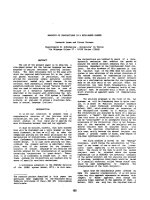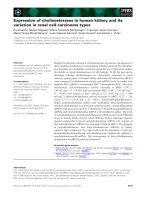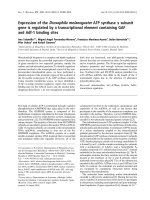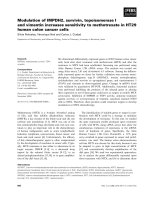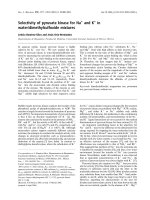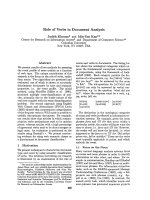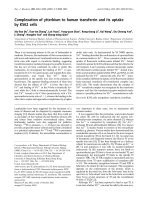Báo cáo khoa học: Expression of cholinesterases in human kidney and its variation in renal cell carcinoma types pdf
Bạn đang xem bản rút gọn của tài liệu. Xem và tải ngay bản đầy đủ của tài liệu tại đây (458.57 KB, 11 trang )
Expression of cholinesterases in human kidney and its
variation in renal cell carcinoma types
Encarnacio
´
n Mun
˜
oz-Delgado
1
, Marı
´a
Fernanda Montenegro
1
, Francisco Javier Campoy
1
,
Marı
´
a Teresa Moral-Naranjo
1
, Juan Cabezas-Herrera
2
, Gyula Kovacs
3
and Cecilio J. Vidal
1
1 Department of Biochemistry and Molecular Biology-A, University of Murcia, Spain
2 Research Unit of Clinical Analysis Service, University Hospital Virgen de la Arrixaca, Murcia, Spain
3 Laboratory of Molecular Oncology, Medical Faculty, Ruprecht-Karls-University of Heidelberg, Germany
Keywords
chromophobe renal cell carcinoma (chRCC);
conventional renal cell carcinoma (cRCC);
glycosylphosphatidylinositol anchor; papillary
renal cell carcinoma (pRCC); renal
oncocytoma
Correspondence
C. J. Vidal, Department of Biochemistry and
Molecular Biology-A, University of Murcia,
Campus de Espinardo, E-30071 Murcia,
Spain
Fax: +34 868 884147
Tel: +34 868 884774
E-mail:
(Received 9 July 2010, revised 10 August
2010, accepted 3 September 2010)
doi:10.1111/j.1742-4658.2010.07861.x
Despite the aberrant expression of cholinesterases in tumours, the question of
their possible contribution to tumorigenesis remains unsolved. The identifica-
tion in kidney of a cholinergic system has paved the way to functional studies,
but details on renal cholinesterases are still lacking. To fill the gap and to
determine whether cholinesterases are abnormally expressed in renal
tumours, paired pieces of normal kidney and renal cell carcinomas (RCCs)
were compared for cholinesterase activity and mRNA levels. In studies with
papillary RCC (pRCC), conventional RCC, chromophobe RCC, and renal
oncocytoma, acetylcholinesterase activity increased in pRCC (3.92 ±
3.01 mUÆmg
)1
, P=0.031) and conventional RCC (2.64 ± 1.49 mUÆmg
)1
,
P = 0.047) with respect to their controls (1.52 ± 0.92 and 1.57 ± 0.44
mUÆmg
)1
). Butyrylcholinesterase activity increased in pRCC (5.12 ± 2.61
versus 2.73 ± 1.15 mUÆmg
)1
, P = 0.031). Glycosylphosphatidylinositol-
linked acetylcholinesterase dimers and hydrophilic butyrylcholinesterase
tetramers predo minated in control and cancerous k idney. Acetylcholinesterase
mRNAs with exons E1c and E1e, 3¢-alternative T, H and R acetylcholinesterase
mRNAs and butyrylcholinesterase mRNA were identified in kidney. The levels
of acetylcholinesterase and butyrylcholinesterase mRNAs were nearly 1000-fold
lower in human kidney than in colon. Whereas kidney and renal tumours
showed comparable levels of acetylcholinesterase mRNA, the content of
butyrylcholinesterase mRNA was increased 10-fold in pRCC. The presence
of acetylcholinesterase and butyrylcholinesterase mRNAs in kidney
supports their synthesis in the organ itself, and the prevalence of glycosyl-
phosphatidylinositol-anchored acetylcholinesterase explains the splicing to
acetylcholinesterase-H mRNA. The consequences of butyrylcholinesterase
upregulation for pRCC growth are discussed.
Structured digital abstract
l
MINT-7992181: BuChE (uniprotkb:P06276) and BuChE (uniprotkb:P06276) bind (MI:0407)
by chromatography technology (
MI:0091)
l
MINT-7992175: AChE (uniprotkb:P22303) and AChE (uniprotkb:P22303) bind (MI:0407)by
chromatography technology (
MI:0091)
Abbreviations
ACh, acetylcholine; AU, arbitrary units; Brij 96, polyoxyethylene-oleyl ether; chRCC, chromophobe renal cell carcinoma; cRCC, conventional
renal cell carcinoma; GPI, glycosylphosphatidylinositol; Iso-OMPA, tetraisopropyl pyrophosphoramide; LCA, Lens culinaris agglutinin; LOH,
loss of heterozygosity; NK, normal kidney; PIPLC, phosphatidylinositol-specific phospholipase C; pRCC, papillary renal cell carcinoma;
RCA, Ricinus communis agglutinin; RCC, renal cell carcinoma; RO, renal oncocytoma.
FEBS Journal 277 (2010) 4519–4529 ª 2010 The Authors Journal compilation ª 2010 FEBS 4519
Introduction
Renal cell carcinomas (RCCs), which account for
2% of adult malignancies, affect about 150 000 peo-
ple per year worldwide [1], more than 85 000 in
European countries and nearly 3000 in Spain, with
1647 deaths in 2005 (WHO-IARC http://www-dep.
iarc.fr/). RCCs arise from the renal tubular epithe-
lium, and, according to their morphological and
molecular criteria, are classified into malignant and
more indolent parenchymal neoplasms [2,3]. The
World Health Organization classification distinguishes
clear cell (conventional) RCC (cRCC) (70–80%),
papillary (chromophile) RCC (pRCC) (10–15%),
chromophobe RCC (chRCC) (3–5%), tumours of
collecting ducts of Bellini (1%), and Xp11 transloca-
tion RCC and unclassified RCC (together 1%).
Benign or less severe tumours are papillary renal cell
adenoma, metanephric adenoma, and renal oncocy-
toma (RO). Deletions at chromosome 3p, mutations
of the VHL suppressor gene and loss of heterozygos-
ity (LOH) of 9p, 14q, 17p and 10q have been
reported in cRCC [4]. Trisomy 7 and 17 and loss of
the Y-chromosome are frequent in pRCC [5]. Loss
at 9p13 has been associated with poor survival in
patients with pRCC [4], and, despite the good prog-
nosis of chRCC, loss of various chromosomes, muta-
tions of p53, LOH at 10q23.3 and telomere
shortening have been reported [6]. RO consists of
mixtures of cells with normal and abnormal karyo-
types [7]. About 4% of renal cancers arise from
hereditary syndromes [8].
Acetylcholinesterase (UniProt P22303) and butyr-
ylcholinesterase (P06276) are enzymes that rapidly
hydrolyse acetylcholine (ACh). The human acetyl-
cholinesterase gene maps at 7q22 [9] and the butyryl-
cholinesterase gene at 3q26 [10]. A range of
3¢-alternatively spliced and 5¢-alternatively spliced ace-
tylcholinesterase mRNAs have been identified [11,12].
The 3¢-alternative mRNAs code for the three classical
catalytic acetylcholinesterase subunits: ‘tailed’ or ‘syn-
aptic’ (T, P22303-1), ‘hydrophobic’ or ‘erythrocytic’
(H, P22303-2), and ‘readthrough’ (R, P22303-4) [11,13].
Acetylcholinesterase-T forms homo-oligomers, the
so-called ‘globular forms’ (G
1
,G
2
, and G
4
), and het-
ero-oligomers, depending on the lack or addition of
structural subunits. Acetylcholinesterase-H adds glyco-
sylphosphatidylinositol (GPI) and forms amphiphilic
monomers (G
1
A
) and dimers (G
2
A
) [14]. The stress-
inducible acetylcholinesterase-R subunit can replace the
T-subunit in oligomers [11]. Five 5¢-alternative acetyl-
cholinesterase mRNAs have been identified in mice and
three in humans [11,12], and acetylcholinesterase-H,
acetylcholinesterase-T and acetylcholinesterase-R
mRNAs starting with exon E1e code for N-terminally
extended acetylcholinesterase subunits (N-acetylcholin-
esterase), whose extension displays a membrane
anchorage motif [11]. A single butyrylcholinesterase
mRNA exists, and its protein product forms G
1
,G
2
and G
4
species, with hydrophilic or amphiphilic proper-
ties according to the folding of the butyrylcholinester-
ase subunit [15].
Besides their hydrolytic action, both acetylcholines-
terase and butyrylcholinesterase seem to play noncata-
lytic roles, which would explain their wide distribution
in tissues and cells [16], including stem cells [17].
Increasing evidence links these noncatalytic actions
with the binding of cholinesterases to several protein
partners. Thus, it has been reported that acetylcholin-
esterase can interact with laminin and collagen IV
[17,18], nicotinic receptors [19], amyloid b-peptide and
presenilin-1 [20], neuronal enolase, the scaffold protein
RACK1 and protein kinase C [21], the corepressor
CtBP [22], and Ran-binding protein [23]. Butyrylcho-
linesterase can also have noncatalytic actions, as
judged by the role of the butyrylcholinesterase-K–apo-
lipoprotein Ee4–amyloid b-peptide complex in Alzhei-
mer’s disease [24,25] and of butyrylcholinesterase itself
in megakaryocytopoiesis suppression and retinal cell
differentiation [16].
The expression of acetylcholinesterase and butyr-
ylcholinesterase in neural and non-neural tumours
[26] and the amplification of their genes in leukae-
mias and ovarian cancer [16,26] support a role for
cholinesterases in carcinogenesis. This notion is given
weight by the aberrant expression and structural
changes of acetylcholinesterase and butyrylcholinest-
erase in cancers of diverse origin [26,27], the tumour-
inducing effect of anticholinesterase agents [26,28],
the relationship between astrocytoma severity and
acetylcholinesterase expression [27], the role of acetyl-
cholinesterase in apoptosis [23], and the downregula-
tion of cholinesterases in metastasized lymph nodes
[29], as well as in colorectal [30] and lung [31] can-
cers.
Despite the long time that has elapsed since the
observation of cholinesterases in mouse kidney [32]
and MDCK cells [33], and, more recently, of ACh and
cholinergic receptors in the human urothelium [34], the
expression of cholinesterases in human kidney has not
been studied yet. The present research was intended to
partially fill this gap by examining the levels of cholin-
esterase activity and mRNAs in human kidney and
their possible variation in tumours.
Cholinesterases in renal carcinomas E. Mun˜ oz-Delgado et al.
4520 FEBS Journal 277 (2010) 4519–4529 ª 2010 The Authors Journal compilation ª 2010 FEBS
Results
Cholinesterase activity in human kidney and
renal tumours
Butyrylcholinesterase activity predominated over ace-
tylcholinesterase activity in healthy kidney (Table 1).
As compared with control specimens, acetylcholinester-
ase activity was 2.6-fold and 1.7-fold increased in
pRCC and cRCC (P < 0.05) (Table 1). Acetylcholin-
esterase activity also rose in chRCC and RO, but in a
non-statistically significant manner. Butyrylcholinester-
ase activity increased 1.9-fold in pRCC (P < 0.05).
Most acetylcholinesterase (77 ± 20%) and butyrylcho-
linesterase activities (92 ± 10%) in unaffected and
cancerous kidney were released by the two-step extrac-
tion procedure. Acetylcholinesterase activity was recov-
ered to a lower extent in the S1 supernatant
(17 ± 12%) than in the S2 supernatant (60 ± 15%),
unlike butyrylcholinesterase activity (70 ± 12% in S1
and 22 ± 7% in S2). No statistically significant differ-
ences between unaffected and cancerous pieces were
observed in the extent of cholinesterase extraction.
Molecular species of acetylcholinesterase in
unaffected and cancerous kidney
Sedimentation analysis with normal kidney (NK)
extracts revealed principal acetylcholinesterase species
with a sedimentation coefficient of 4.0 ± 0.3S
(80 ± 7%) and less abundant species with a sedimenta-
tion coefficient of 2.4 ± 0.3S (20 ± 5%) (Fig. 1A).
Table 1. Acetylcholinesterase and butyrylcholinesterase activities in noncancerous kidney (Control) and renal cell carcinoma (Tumour). Activi-
ties are given as mean ± standard deviation; 1 mU of cholinesterase activity is equal to 1 nmol of substrate split per minute. P-values were
calculated with the Wilcoxon signed rank test; bold type indicates significant differences for 95% confidence.
Acetylcholinesterase (mU per mg protein) Butyrylcholinesterase (mU per mg protein)
n Control Tumour P-value Control Tumour P-value
pRCC 7 1.52 ± 0.92 3.92 ± 3.01 0.031 2.73 ± 1.15 5.12 ± 2.61 0.031
cRCC 7 1.57 ± 0.44 2.64 ± 1.49 0.047 4.15 ± 1.14 2.96 ± 2.05 0.195
chRCC 6 1.75 ± 0.99 2.93 ± 3.33 0.688 3.01 ± 0.94 2.04 ± 0.80 0.094
RO 6 1.82 ± 1.54 1.34 ± 0.71 0.687 2.45 ± 0.64 1.71 ± 0.76 0.156
AB C
Fig. 1. Distribution of cholinesterase species in human kidney and RCCs. (A) Representative sedimentation profiles with acetylcholinesterase
species in S1 + S2 supernatants of NK and pRCC. (B) Cleavage of the hydrophobic moiety in renal acetylcholinesterase. Sedimentation
patterns showing acetylcholinesterase species in samples incubated without (PIPLC–) and with hydroxylamine and PIPLC (PIPLC+); see
Experimental procedures. (C) Sedimentation patterns with butyrylcholinesterase species in S1 + S2 supernatants of NK and pRCC. C and P
in profiles denote catalase and alkaline phosphatase.
E. Mun˜ oz-Delgado et al. Cholinesterases in renal carcinomas
FEBS Journal 277 (2010) 4519–4529 ª 2010 The Authors Journal compilation ª 2010 FEBS 4521
According to their sedimentation coefficients and phe-
nyl-agarose adsorption (Fig. 2, sedimentation profile for
fraction F82), the 4.0S and 2.4S forms were assigned to
amphiphilic dimers (G
2
A
) and monomers (G
1
A
) [35].
Their synthesis was unaffected by malignancy, as judged
by the almost unchanged distribution of acetylcholines-
terase species in NK, pRCC (Fig. 1A), cRCC, chRCC
and RO (sedimentation profiles not shown).
The observation of GPI-anchored acetylcholinester-
ase in epithelial tissues [36,37] prompted us to study
the sensitivity of renal acetylcholinesterase to phospha-
tidylinositol-specific phospholipase C (PIPLC). The
results showed that, in contrast to the amphiphilic
GPI-linked G
2
A
acetylcholinesterase of beef erythro-
cytes, which became fully hydrophilic (G
2
H
) after treat-
ment with phospholipase, only 20% of the renal G
2
A
species did so (profiles not shown). Nevertheless, the
fact that the conversion extent was increased to 40–
50% by prior incubation with hydroxylamine (Fig. 1B)
revealed GPI moieties in at least half of renal acetyl-
cholinesterase. Although the low sensitivity of kidney
(Fig. 1B) and erythrocyte acetylcholinesterase to PIP-
LC [38] might suggest a blood origin for renal acetyl-
cholinesterase, the presence in kidney of G
1
A
acetylcholinesterase, which is absent from erythrocytes,
and the difference between acetylcholinesterases of kid-
ney and erythrocytes in the extent of binding with the
lectins concanavalin A, Lens culinaris agglutinin
(LCA), and Ricinus communis agglutinin (RCA)
(Fig. 3), ruled out the blood origin and supported the
renal cells themselves as the most probable source of
kidney acetylcholinesterase.
Butyrylcholinesterase species in healthy kidney
and RCC
The kidney butyrylcholinesterase activity distributed
between principal 12.1 ± 0.2S species (70 ± 7%) and
less abundant 4.9 ± 0.2S species (30 ± 12%)
(Fig. 1C). According to their sedimentation coefficients
and hydrophilic properties, as judged by their inability
to be retained in phenyl–agarose (Fig. 2, profiles for
fractions F6–F10), the butyrylcholinesterase species
were assigned to hydrophilic tetramers (G
4
H
) and
monomers (G
1
H
). It is worth noting the profitable use
of phenyl–agarose to resolve not only hydrophilic and
amphiphilic cholinesterase species [37] but also hydro-
philic butyrylcholinesterase tetramers and monomers,
taking advantage of the faster elution of the former
(Fig. 2, profiles F6–F10). Although the G
4
H
butyrylch-
olinesterase species were always more abundant than
the G
1
H
species (Fig. 1C), subtle differences between
normal samples and cancerous pieces (even from the
same tumour type) in the proportion of butyrylcholin-
esterase species prevented us from ascertaining possible
changes in their distribution as the result of cancer.
Fig. 2. Phenyl–agarose chromatography
with renal cholinesterases. The S1 superna-
tant of NK was passed through phenyl–
agarose, and fractions with unbound and
Triton X-100 (TX-100)-eluted cholinesterase
activity were assayed for acetylcholinester-
ase and butyrylcholinesterase. Cholinester-
ase species in butyrylcholinesterase-rich
fractions (F6–F10) and in the acetylcholines-
terase-rich fraction (F82) were identified by
centrifugation as in Fig. 1.
Cholinesterases in renal carcinomas E. Mun˜ oz-Delgado et al.
4522 FEBS Journal 277 (2010) 4519–4529 ª 2010 The Authors Journal compilation ª 2010 FEBS
Levels of acetylcholinesterase and
butyrylcholinesterase mRNAs
Regardless of healthy or pathological status, human
kidney contained acetylcholinesterase mRNAs with
exons E1c and E1e, the three 3¢-alternatively spliced
acetylcholinesterase mRNAs (R, H, and T), and the
butyrylcholinesterase transcript (Fig. 4). Although
RT-PCR quantifications are not completely reliable,
and only give an approximate idea of the relative
content of mRNAs, real-time PCR results allowed us
to detect low levels of acetylcholinesterase mRNAs
in kidney. Thus, unaffected renal pieces displayed
comparable quantities of acetylcholinesterase mRNAs
with E1c (96 ± 62 copies per 10
6
copies of b-actin
mRNA) and E1e (148 ± 80 copies). The E1a-bearing
acetylcholinesterase mRNA was undetected in renal
pieces. No significant differences between unaffected
kidney, pRCC, cRCC, chRCC and RO in the con-
tent of the 5¢-alternative acetylcholinesterase mRNAs
were observed.
Concerning the 3¢-alternative acetylcholinesterase
mRNAs, NK had similar amounts of acetylcholinester-
ase-R (30 ± 17 copies) and acetylcholinesterase-H
(24 ± 19 copies) mRNAs, and their quantities were
unmodified in the different classes of tumours. The
amount of acetylcholinesterase-T mRNA in control
kidney (81 ± 67 copies) did not statistically vary in
pRCC, cRCC, and RO, and tended to decrease in
chRCC (20 ± 10 copies; P = 0.06) (Fig. 4). Finally,
the level of butyrylcholinesterase mRNA in unaffected
kidney (19 ± 12 copies) was little changed in cRCC,
chRCC, and RO, but significantly increased in pRCC
(237 ± 161 copies, P = 0.008) (Fig. 4).
Discussion
The histochemical observation of acetylcholinesterase
and butyrylcholinesterase in mammalian kidney [32]
and canine MDCK renal cells [33] justified a detailed
biochemical study of renal cholinesterases, but it had
not yet been performed. The present results and our
previous data showing GPI-anchored acetylcholinester-
ase dimers and monomers in human kidney (Figs 1
and F2, F82), meningioma [37], breast [36], lung [31]
and gut [30] demonstrate the capacity of epithelial tis-
sues for translating the acetylcholinesterase-H mRNA,
and undermines the widely accepted idea that the GPI-
bound acetylcholinesterase of mammals arises almost
exclusively from blood cells.
As in human gut [30], butyrylcholinesterase activity
prevailed over acetylcholinesterase activity in kidney.
The comparable distribution of G
4
H
and G
1
H
Fig. 4. Real-time PCR results showing acetylcholinesterase and
butyrylcholinesterase mRNA levels in control kidney and renal
tumours. Mean values of five or six determinations with six or
seven paired samples of unaffected and cancerous kidney.
*P < 0.001.
Fig. 3. Lectin interaction patterns of cho-
linesterases of human kidney, erythrocytes,
and blood plasma. Extracts of kidney and
erythrocytes, along with blood plasma sam-
ples, were incubated with lectin-free Sepha-
rose 4B (control) and Sepharose-linked
lectins. Then, the agarose beads with bound
cholinesterase activity were removed, and
the unbound cholinesterase activity was
assayed. The percentage of lectin-bound
activity was calculated by comparing cholin-
esterase activity in lectin-incubated and
control assays. Results are means of four
experiments. *P < 0.05, **P < 0.01.
E. Mun˜ oz-Delgado et al. Cholinesterases in renal carcinomas
FEBS Journal 277 (2010) 4519–4529 ª 2010 The Authors Journal compilation ª 2010 FEBS 4523
butyrylcholinesterase in kidney (Fig. 1C), meningioma
[37], breast [36], and colon [30], and the observation
of butyrylcholinesterase mRNA in kidney (Fig. 4),
colon [30], and cancerous cell lines [39], support the
idea of butyrylcholinesterase synthesis in the organs
themselves. Nevertheless, the great quantity of butyr-
ylcholinesterase activity in blood plasma [40] might
lead us to think that renal butyrylcholinesterase
arises totally or in part from blood. However, bear-
ing in mind the need for vigorous irrigation to
favour tumour growth and the abundance of G
4
H
butyrylcholinesterase in plasma, if blood were the
source of kidney butyrylcholinesterase, an appreciable
increase in butyrylcholinesterase activity of chRCC,
cRCC, and RO, instead of its invariability (Table 1),
should have been expected, along with a robust
increase in the proportion of G
4
H
butyrylcholinester-
ase. The incomplete binding of renal butyrylcholinest-
erase to the lectin LCA, which fully reacts with the
enzyme of plasma (Fig. 3), strongly supports the
renal origin of the butyrylcholinesterase activity
assayed in kidney. This proposal is in agreement
with the cytochemical staining of acetylcholinesterase
in the capsule of Bowman [41] and of acetylcholines-
terase and butyrylcholinesterase in the glomerulus
and the tubule, which is stronger for acetylcholines-
terase in the rough endoplasmic reticulum of mesan-
gial cells and for butyrylcholinesterase in the
reticulum of endothelial cells [32]. Thus, it is likely
that epithelial, mesangial and endothelial cells can all
contribute to renal cholinesterase activity, but the
most important point is the comparable profiles of
cholinesterase forms in control and cancerous kidney,
which rules out major changes in their biosynthesis
as the result of cancer.
As regards the range of cholinesterase mRNAs, kid-
ney and renal tumours share the capacity to express
the three 3¢-spliced mRNAs (R, H, and T) and the
5¢-spliced acetylcholinesterase mRNAs that start with
E1c and E1e (Fig. 4). As the E1e acetylcholinesterase
mRNA codes for N-terminally extended acetylcholin-
esterase [11], whose extension is selectively associated
with apoptosis of neural cells [42], the E1e mRNA
might behave as a brake to prevent or attenuate tumour
progression in kidney and other organs. As expected,
human kidney contained much less acetylcholinesterase
mRNA ( 150 copies for acetylcholinesterase-R +
acetylcholinesterase-H + acetylcholinesterase-T mRNAs)
(Fig. 4) than gut ( 2500 copies) [30], mouse brain
( 35 000 copies) [12], or muscle ( 10 000 copies)
[43]. The presence of acetylcholinesterase-T mRNA in
kidney (Fig. 4) contrasts with the absence of catalytic
acetylcholinesterase-T protein from kidney and cancer-
ous cell lines of lung, breast, and gut [39], a feature
that might be attributed to microRNA-induced trans-
lational repression of the acetylcholinesterase-T
mRNA in epithelial cells. In this respect, there is
evidence of a regulatory role for microRNA-132 in the
expression of acetylcholinesterase in leukocytes [44],
but other reasons may exist, e.g. fast degradation of
acetylcholinesterase-T protein, rapid secretion of
oligomers [13], or synthesis of catalytically incompetent
protein [14].
Concerning the variation of cholinesterase activity in
renal tumours, the 2.6-fold and 1.7-fold increased
acetylcholinesterase activities in pRCC and cRCC
(Table 1), despite their unchanging levels of acetylcho-
linesterase mRNAs (Fig. 4), point to malignancy-
driven changes in translational efficiency. This increase
of acetylcholinesterase activity in pRCC and cRCC is
in agreement with the upregulation of acetylcholines-
terase in tumour cell lines [27], but not with the reduc-
tion of activity in cancerous lymph nodes [29] and gut
[30]. The reports in ovarian carcinoma showing ampli-
fication of the ACHE gene on the one hand, and
frequent LOH at 7q22 on the other [26], besides the
finding of a negative correlation between upregulation
of acetylcholinesterase with androgens in ovarian
cancer and patient survival [45], illustrate how complex
the changes in acetylcholinesterase expression can
be in ovarian tumours and, most probably, in other
cancers [27].
Our observations regarding the higher acetylch-
olinesterase activity in kidney tumours suggest that a
relationship may exist between increased acetylcholin-
esterase activity and cell proliferation, a link that has
also been suggested for hyperproliferation of lympho-
cytes in thymomas [46]. However, other studies have
implicated acetylcholinesterase in apoptotic cell death
[47]. These ideas are not necessarily contradictory, if
one considers the widely accepted idea that the effects
of acetylcholinesterase depend on the cell type and
differentiation state, the levels of 5¢ -spliced and
3¢-spliced acetylcholinesterase mRNAs, their lifespan
and translational efficiency, and the capacity of the
translated product to bind to protein partners.
The upregulation of butyrylcholinesterase in pRCC
(Table 1 and Fig. 4) is in agreement with previous
reports on squamous cell lung [48], breast [49] and
hepatic [50] carcinomas. In this respect, it is worth
mentioning the recommended use of butyrylcholinest-
erase overexpression as a predictive survival index in
liver cancer [51]. Considering the butyrylcholinesterase
contribution to immortalization of several SV40-trans-
formed cell types and to maturation of megakaryo-
cytes [16], a role for butyrylcholinesterase in the
Cholinesterases in renal carcinomas E. Mun˜ oz-Delgado et al.
4524 FEBS Journal 277 (2010) 4519–4529 ª 2010 The Authors Journal compilation ª 2010 FEBS
proliferation ⁄ differentiation of different cell types has
been proposed, and although some information on this
issue is available for butyrylcholinesterase-null retinal
cells [52], further research is required to assess the
involvement of butyrylcholinesterase in cell prolifera-
tion and cancer. The higher increase in butyrylcholin-
esterase mRNA than activity levels in pRCC may
point at tumour-related elevations in butyrylcholinest-
erase-targeted micro-RNA(s). In contrast, acetylcholin-
esterase mRNA levels remained unchanged and the
enzymatic activity increased in pRCC. This may inver-
sely reflect a tumour-associated decline in acetylcholin-
esterase mRNA-targeted micro-RNA(s). Given the
increasing importance of micro-RNAs in tumorigenic
processes, the proposal should be seriously considered
in further studies.
The increased acetylcholinesterase and butyrylcho-
linesterase activities in pRCC (Table 1) may indeed
represent a side effect of the transformed cell pheno-
type, but the binding of the cytotoxic cisplatin to
acetylcholinesterase [53] and probably to butyrylcho-
linesterase suggests a relationship between the
increased cholinesterase activity and pRCC chemore-
sistance. Nevertheless, the crucial question is whether
the increase in cholinesterase activity contributes or
not to pRCC growth. Obviously, any increase in cho-
linesterase activity would reduce the availability of
ACh and would therefore impair cholinergic
responses. The origin of pRCC in the tubular epithe-
lium [54] and the presence in it of muscarinic and
nicotinic receptors [34,55] support a role for ACh in
renal tubules. The increase in cholinesterase activity
in pRCC, the subsequent decrease in ACh availability
and the lowered cholinergic activation may have
pathological consequences, but further research is
needed to clarify functional aspects of cholinergic sig-
nalling in the urothelium.
In summary, our results show that human kidney
contains abundant butyrylcholinesterase activity,
distributed among G
4
H
and G
1
H
species, and less
acetylcholinesterase activity as GPI-anchored species.
Whereas the observation of acetylcholinesterase and
butyrylcholinesterase mRNAs in kidney supports their
synthesis in the organ itself, the prevalence of GPI-
linked acetylcholinesterase in kidney and other epithe-
lial tissues explains their acetylcholinesterase-H mRNA
content. The fact that G
4
H
and G
1
H
butyrylcholinester-
ase are similarly distributed in various epithelia sup-
ports their programmed synthesis. The overexpression
of cholinesterases in pRCC contrasts with their under-
expression in cancerous lymph nodes and gut, and
these features highlight the complex regulation of cho-
linesterases in cancer.
Experimental procedures
Materials
Acetylthiocholine and butyrylthiocholine iodide, 5,5¢-di-
thiobis(2-nitrobenzoic acid), 1,5-bis(4-allyldimethylam-
moniumphenyl)-pentan-3-one dibromide (BW284c51),
tetraisopropyl pyrophosphoramide (Iso-OMPA), Brij 96,
antiproteinases, protein markers for sedimentation analysis
(beef liver catalase and bovine intestine alkaline phospha-
tase), phenyl–agarose, lectin-free Sepharose 4B and agarose-
bound concanavalin A, LCA, RCA, DNase I, ethidium
bromide and DNA size markers were all purchased from
Sigma (St Louis, MO, USA). Moloney murine leukaemia
virus reverse transcriptase, random primers and the Purelink
Micro-to Midi total RNA Purification System for total
RNA extraction were provided by Invitrogen (Carlsbad,
CA, USA), and dNTPs by Eppendorf (Hamburg, Germany).
TaqMan PCR Master Mix was from Applied Biosystems
(Foster City, CA, USA), and ribonuclease inhibitor from
Amersham-Pharmacia (Buckinghamshire, UK). PIPLC of
Bacillus thuringiensis was kindly donated by N. M. Hooper
(University of Leeds, UK).
Patients and tumours
Kidney specimens were taken from patients who had under-
gone tumour nephrectomy. They were properly informed
about the use of samples for research. After surgery, paired
samples of renal tumours and adjacent unaffected tissue
were taken, snap-frozen in liquid nitrogen, and stored at
)80 °C. Histological diagnosis was made according to the
Heidelberg Classification of Renal Cell Tumours [2]. Seven
specimens of pRCC, seven of cRCC, six of chRCC, and six
of RO, besides adjacent pieces of unaffected tissue, were
used in this study. This research was approved by the ethics
committee of the University of Murcia.
Extraction and assay of cholinesterases
Kidney pieces were homogenized with detergent-free
NaCl ⁄ Tris (1 m NaCl, 50 mm MgCl
2
,10mm Tris, pH 7.0)
containing the antiproteinases benzamidine (2 mm), pepsta-
tin A (10 lgÆmL
)1
), leupeptin (20 lgÆmL
)1
), aprotinin
(20 UÆmL
)1
), soybean trypsin inhibitor (0.1 mgÆmL
)1
), and
bacitracin (1 mgÆmL
)1
). After centrifugation at 170 000 g
for 1 h at 4 °C in a 70 Ti rotor (Beckman, Palo Alto, CA,
USA), the S1 supernatant with loosely bound cholinesteras-
es was saved. The pellet was re-extracted with NaCl ⁄ Tris
supplemented with 1% Brij 96 and antiproteinases. After
centrifugation as above, the S2 supernatant with tightly
bound cholinesterases was recovered. Acetylcholinesterase
was extracted from human erythrocytes as reported
elsewhere [38].
E. Mun˜ oz-Delgado et al. Cholinesterases in renal carcinomas
FEBS Journal 277 (2010) 4519–4529 ª 2010 The Authors Journal compilation ª 2010 FEBS 4525
Cholinesterase activity was determined by the Ellman
method: acetylcholinesterase with 1 mm acetylthiocholine
and 50 lm Iso-OMPA, and butyrylcholinesterase with
1mm butyrylthiocholine and 10 lm BW284c51 [36]. Unspe-
cific esterase activity, measured in assays including both
BW284c51 and Iso-OMPA, was discounted for the calcula-
tion of true acetylcholinesterase and butyrylcholinesterase
activities. Cholinesterase activity is given in nanomoles of
the preferred substrate hydrolysed per min at 25 °C (mU).
Acetylthiocholine hydrolysis attributable to unspecific
esterases in unaffected and cancerous pieces amounted to
15–25%, and that of butyrylthiocholine to 20–30%. True
cholinesterase activity was calculated by subtracting the
unspecific hydrolysis from the total hydrolysis of the
substrate. Cholinesterase activity in sedimentation profiles
is given in arbitrary units (AU), in which case one unit of
activity refers to an increase of 0.001 absorbance units per
microlitre of sample and per min, but normalized for the
volume of sample added to the gradient. Protein concentra-
tion was determined by the Lowry method [36].
Characterization of cholinesterase components
Acetylcholinesterase and butyrylcholinesterase species were
resolved by sedimentation analysis and identified by their
sedimentation coefficients [36]. A mixture of the S1 and S2
supernatants (0.5 mL each) plus the sedimentation markers
beef liver catalase (11.4S) and intestine alkaline phospha-
tase (6.1S) was loaded onto 5–20% sucrose gradients con-
taining 0.5% Brij 96. The gradient tubes were centrifuged
at 170 000 g for 24 h at 4 °C in a Beckman SW41Ti rotor.
Overlapping peaks were resolved with the peak-fit soft-
ware from SPSS. The percentage of each cholinesterase
form was determined by comparing cholinesterase activity
under each peak area and under the entire profile.
Amphiphilic acetylcholinesterase and hydrophilic butyr-
ylcholinesterase in the S1 supernatant of kidney were
separated by taking advantage of the capacity of phenyl–
agarose to adsorb amphiphilic cholinesterases [37]. In
addition, the faster elution of butyrylcholinesterase
tetramers permitted their separation from butyrylcholinest-
erase monomers [12]. The presence of GPI residues in renal
acetylcholinesterase was tested by its exposure to PIPLC of
B. thuringiensis. Samples were incubated in the absence
(control) and presence of PIPLC, both without and with
prior treatment with alkaline hydroxylamine, as reported
previously [30].
Lectin interaction assays allowed us to distinguish
between homologous cholinesterase forms of kidney and
blood. Mixtures of S1 and S2 extracts of kidney were incu-
bated with lectin-free Sepharose 4B (control) and with
Sepharose-linked lectins. Samples of Triton X-100-extracted
A
B
Fig. 5. Primers used to quantify acetylcho-
linesterase and butyrylcholinesterase
mRNAs by real-time PCR. (A) Scheme
showing the position of the primers. (B) Pri-
mer sequences and PCR product sizes.
Gene ID and accession numbers are as fol-
lows: ACHE, 43 and ENSG 00000087085;
BCHE, 590 and ENSG 0000011420; and
ACTB (b-actin), 60 and ENSG 00000075624.
Cholinesterases in renal carcinomas E. Mun˜ oz-Delgado et al.
4526 FEBS Journal 277 (2010) 4519–4529 ª 2010 The Authors Journal compilation ª 2010 FEBS
acetylcholinesterase from human erythrocytes and from
blood plasma were also incubated. After incubation,
the lectin–cholinesterase complexes were removed by
centrifugation at 3000 g for 5 min at 4 °C in microcentrifuge
(Denver Instrument Company, Argada, CO, USA), and the
unbound cholinesterase activity was assayed. The percentage
of lectin-bound activity was determined by comparing
the activity in lectin-incubated and control assays [12].
Quantification of cholinesterase mRNAs by real
time RT-PCR
Total RNA was extracted from frozen renal specimens with
the Purelink Micro-to Midi total RNA Purification System,
after a first extraction with Trizol. For reverse transcrip-
tion, 5 lg of DNAse I-treated RNA was denatured at
70 °C for 10 min and cooled rapidly. A mixture of buffer,
dithiothreitol, dNTPs, random primers and ribonuclease
inhibitor was added before heating for 2 min at 42 °C.
Then, 200 U of Moloney murine leukaemia virus reverse
transcriptase was added, and synthesis of cDNAs was per-
formed for 50 min at 42 °C in a volume of 20 lL. Finally,
samples were heated for 15 min at 72 °C and kept frozen.
For PCR, primer pairs were designed to amplify the
cDNAs derived from the 5¢-alternative acetylcholinesterase
mRNAs that include exons E1c and E1e, the 3¢-alternative
acetylcholinesterase mRNAs (R, H, or T), the butyrylcho-
linesterase mRNA, and the b-actin mRNA, used as the
internal standard. The sequence and position of the prim-
ers, as well as the size of the PCR products, are provided
in Fig. 5. cDNA was amplified in an Applied Biosys-
tems 7500 real-time PCR system, using a MicroAmp Opti-
cal 96-well Reaction Plate with 25 lL of reaction volume.
The buffered medium contained 2 lL of variable dilutions
of cDNA, 0.2 lm specific primers, and the TaqMan PCR
master mix. Reactions comprised a first step of 10 min at
95 °C, followed by 45 cycles of 15 s at 95 °C and 60 s at
60 °C. A final dissociation stage allowed us to study the
melting curves. The relative contents of acetylcholinesterase
and butyrylcholinesterase cDNAs, with respect to b-actin
cDNA, was determined by the 2
)DCt
method. PCR pro-
ducts were separated in 3% agarose gels and visualized
with ethidium bromide. Their lengths, calculated with DNA
size markers and gelpro software, coincided with the
expected sizes. For reliability, the PCR products derived
from acetylcholinesterase-R, acetylcholinesterase-E1c and
acetylcholinesterase-E1e mRNAs were sequenced in a
Genetic Analyzer ABI Prism 3130 (Applied Biosystems).
The relative amounts of cholinesterase mRNAs are given as
number of copies per 10
6
copies of the b-actin mRNA.
Statistical analysis
The results are expressed as mean ± standard deviation.
Statistical differences in cholinesterase activity between nor-
mal and malignant kidney pieces were assessed with the
Wilcoxon signed rank test. Data were analysed by consider-
ing paired samples (control and neoplastic samples of the
same patient). The significance of differences in lectin bind-
ing to cholinesterases was evaluated with Student’s t-test.
Acknowledgements
We thank N. Hooper (University of Leeds, UK) for
providing us with PIPLC from B. thuringiensis and
Centro Nacional de Investigaciones Oncolo
´
gicas of
Spain (CNIO), as well as J. E. Herna
´
ndez-Barcelo
´
and
F. Ruiz-Espejo (Hospital Virgen de la Arrixaca of
Murcia, Spain) for the kind donation of unaffected
kidney, renal cancer and blood samples. This research
was supported by the Instituto de Salud Carlos III of
Spain (Grant FIS-PI041504) and the Fundacio
´
nSe
´
ne-
ca of Murcia (Grant 08648 ⁄ PI08), which also provided
a scholarship for M. F. Montenegro.
References
1 Jemal A, Siegel R, Ward E, Hao X, Xu J & Thun MJ
(2009) Cancer statistics. CA Cancer J Clin 59, 225–249.
2 Kovacs G, Akhtar M, Beckwith BJ, Bugert P, Cooper
CS, Delahunt B, Eble JN, Fleming S, Ljungberg B,
Medeiros LJ et al. (1997) The Heidelberg classification
of renal cell tumours. J Pathol 183, 131–133.
3 Moch H, Gasser T, Amin MB, Torhorst J, Sauter G &
Mihatsch MJ (2000) Prognostic utility of the recently
recommended histologic classification and revised TNM
staging system of renal cell carcinoma. A Swiss experi-
ence with 588 tumors. Cancer 89, 604–614.
4 Hansel DE (2006) Genetic alterations and histopatho-
logic findings in familial renal carcinoma. Histol Histo-
pathol 21, 437–444.
5 Kovacs G, Fuzesi L, Emanual A & Kung HF (1991)
Cytogenetics of papillary renal cell tumors. Genes
Chromosomes Cancer 3, 249–255.
6 Brunelli M, Eble JN, Zhang S, Martignoni G,
Delahunt B & Cheng L (2004) Eosinophilic and classic
chromophobe renal cell carcinomas have similar
frequent losses of multiple chromosomes from among
chromosomes 1, 2, 6, 10, and 17, and this pattern of
genetic abnormality is not present in renal oncocytoma.
Mod Pathol 18, 161–169.
7 Zubakov D, Stupar Z & Kovacs G (2006) Differential
expression of a new isoform of DLG2 in renal onco-
cytoma. BMC Cancer 6, 106. doi:10.1186/1471-2407-
6-106.
8 Linehan WM, Bratslavsky G, Pinto PA, Schmidt LS,
Neckers L, Bottaro DP & Srinivasan R (2010) Molecu-
lar diagnosis and therapy of kidney cancer. Annu Rev
Med 61, 329–343.
E. Mun˜ oz-Delgado et al. Cholinesterases in renal carcinomas
FEBS Journal 277 (2010) 4519–4529 ª 2010 The Authors Journal compilation ª 2010 FEBS 4527
9 Getman DK, Eubanks JH, Camp S, Evans GA &
Taylor P (1992) The human gene encoding AChE is
located on the long arm of chromosome 7. Am J Hum
Genet 51, 170–177.
10 Allderdice PW, Gardner HA, Galutira D, Lockridge O,
La Du BN & McAlpine PJ (1991) The cloned butyr-
ylcholinesterase (BCHE) gene maps to a single chromo-
some site, 3q26. Genomics 11, 452–454.
11 Meshorer E & Soreq H (2006) Virtues and woes of
AChE alternative splicing in stress-related neuropathol-
ogies. Trends Neurosci 29, 216–224.
12 Ferna
´
ndez-Go
´
mez FJ, Mun
˜
oz-Delgado E,
Montenegro MF, Campoy FJ, Vidal CJ & Jorda
´
nJ
(2010) Cholinesterase activity in brain of senescence-
accelerated-resistant mouse SAMR1 and its variation in
brain of senescence-accelerated-prone mouse SAMP8.
J Neurosci Res 88, 155–166.
13 Massoulie
´
J, Perrier N, Noureddine H, Liang D &
Bon S (2008) Old and new questions about
cholinesterases. Chem Biol Interact 175, 30–44.
14 Nieto-Cero
´
nS,Sa
´
nchez del Campo LF, Mun
˜
oz-
Delgado E, Vidal CJ & Campoy FJ (2005) Muscular
dystrophy by merosin deficiency decreases
acetylcholinesterase activity in thymus of Lama2dy
mice. J Neurochem 95, 1035–1046.
15 Altamirano CV & Lockridge O (1999) Conserved aro-
matic residues of the C-terminus of human butyrylcho-
linesterase mediate the association of tetramers.
Biochemistry 38, 13414–13422.
16 Mack A & Robitzki A (2000) The key role of butyr-
ylcholinesterase during neurogenesis and neural disor-
ders: an antisense-5¢butyrylcholinesterase-DNA study.
Prog Neurobiol 60 , 607–628.
17 Paraoanu LE, Steinert G, Koehler A, Wessler I &
Layer PG (2007) Expression and possible functions of
the cholinergic system in a murine embryonic stem cell
line. Life Sci 80, 2375–2379.
18 Johnson G, Swart C & Moore SW (2008) Non-enzy-
matic developmental functions of acetylcholinesterase –
the question of redundancy. FEBS J 275, 5129–5138.
19 Greenfield S, Zimmermann M & Bond CE (2008)
Non-hydrolytic functions of acetylcholinesterase. The
significance of C-terminal peptide. FEBS J 275, 604–
611.
20 Silveyra MX, Evin G, Montenegro MF, Vidal CJ,
Martı
´
nez S, Culvenor JG & Sa
´
ez-Valero J (2008) Prese-
nilin-1 interacts with acetylcholinesterase and alters its
enzymatic activity and glycosylation. Mol Cell Biol 28,
2908–2919.
21 Mor I, Bruck T, Greenberg D, Berson A, Schreiber L,
Grisaru D & Soreq H (2008) Alternate AChE-R vari-
ants facilitate cellular metabolic activity and resistance
to genotoxic stress through enolase and RACK1 inter-
actions. Chem Biol Interact 175, 11–21.
22 Perry C, Pick M, Podoly E, Gilboa-Geffen A,
Zimmerman G, Sklan EH, Ben-Shaul Y, Diamant S &
Soreq H (2007) Acetylcholinesterase ⁄ C terminal binding
protein interactions modify Ikaros functions, causing
T lymphopenia. Leukemia 21, 1472–1480.
23 Gong X, Ye W, Zhou H, Ren X, Zhigang L, Zhou W,
Wu J, Gong Y, Ouyang Q, Zhao X et al. (2009) Ran-
BPM is an acetylcholinesterase-interacting protein that
translocates into the nucleus during apoptosis. Acta
Biochim Biophys Sin 41, 883–891.
24 Darreh-Shori T, Modiri N, Blennow K, Baza S,
Kamil C, Ahmed H, Andreasen N & Nordberg A
(2010) The apolipoprotein E varepsilon4 allele plays
pathological roles in AD through high protein expres-
sion and interaction with butyrylcholinesterase. Neuro-
biol Aging doi:10.1016/j.neurobiolaging.2009.07.015.
25 Darreh-Shori T, Forsberg A, Modiri N, Andreasen
N, Blennow K, Kamil C, Ahmed H, Almkvist O,
Lanstro
¨
ng B & Nordberg A (2010) Differential levels
of apolipoprotein E and butyrylcholinesterase show
strong association with pathological signs of
Alzheimer’s disease in the brain in vivo.
Neurobiol Aging doi:10.1016/j.neurobiolaging.2010.04.
028.
26 Vidal CJ (2005) Expression of cholinesterases in brain
and non-brain tumours. Chem Biol Interact 157–158,
227–232.
27 Perry C, Sklan EH, Birikh K, Shapira M, Trejo L,
Eldor A & Soreq H (2002) Complex regulation of
acetylcholinesterase gene expression in human brain
tumors. Oncogene 21, 8428–8441.
28 Calaf GM, Parra E & Garrido F (2007) Cell prolifera-
tion and tumor formation induced by eserine, an acetyl-
cholinesterase inhibitor, in rat mammary gland. Oncol
Rep 17, 25–33.
29 Ruiz-Espejo F, Cabezas-Herrera J, Illana J, Campoy FJ,
Mun
˜
oz-Delgado E & Vidal CJ (2003) Breast cancer
metastasis alters acetylcholinesterase activity and the
composition of enzyme forms in axillary lymph nodes.
Breast Cancer Res Treat 80, 105–114.
30 Montenegro MF, Ruiz-Espejo F, Campoy FJ, Mun
˜
oz-
Delgado E, Pa
´
ez de la Cadena M, Rodrı
´
guez-Berrocal
FJ & Vidal CJ (2006) Cholinesterases are down-
expressed in human colorectal carcinoma. Cell Mol Life
Sci 63, 2175–2182.
31 Martı
´
nez-Moreno P, Nieto-Cero
´
n S, Torres-Lanzas J,
Ruiz-Espejo F, Tovar-Zapata I, Martı
´
nez-Herna
´
ndez P,
Rodrı
´
guez-Lo
´
pez JN, Vidal CJ & Cabezas-Herrera J
(2006) Cholinesterase activity of human lung tumours
varies according to their histological classification.
Carcinogenesis 27, 429–436.
32 Suda A (1986) A histochemical localization of acetyl-
cholinesterase and cholinesterase activities in mamma-
lian kidneys. Acta Histochem 79, 107–114.
Cholinesterases in renal carcinomas E. Mun˜ oz-Delgado et al.
4528 FEBS Journal 277 (2010) 4519–4529 ª 2010 The Authors Journal compilation ª 2010 FEBS
33 Veronesi B (1996) Characterization of the MDCK cell
line for screening neurotoxicants. Neurotoxicology 17,
433–443.
34 Wessler I & Kirkpatrick CJ (2008) Acetylcholine
beyond neurons: the non-neuronal cholinergic system in
humans. Br J Pharmacol 154, 1558–1571.
35 Garcı
´
a-Ayllo
´
n MS, Sa
´
ez-Valero J, Piqueras-Lo
´
pez C &
Vidal CJ (1999) Characterization of molecular forms of
acetyl- and butyrylcholinesterase in human acoustic
neurinomas. Neurosci Lett 274, 56–60.
36 Ruiz-Espejo F, Cabezas-Herrera J, Illana J, Campoy FJ
& Vidal CJ (2002) Cholinesterase activity and acetyl-
cholinesterase glycosylation are altered in human breast
cancer. Breast Cancer Res Treat 72, 11–22.
37 Sa
´
ez-Valero J & Vidal CJ (1996) Biochemical properties
of acetyl- and butyrylcholinesterase in human meningi-
oma. Biochim Biophys Acta 1317, 210–218.
38 Go
´
mez JL, Nieto-Cero
´
n S, Campoy FJ, Mun
˜
oz-
Delgado E & Vidal CJ (2003) Purification and
properties of hydrophilic dimers of acetylcholinesterase
from mouse erythrocytes. Int J Biochem Cell Biol 35,
1109–1118.
39 Martı
´
nez-Lo
´
pez de Castro A, Nieto-Cero
´
n S, Pons-
Castillo A, Galvis-Martı
´
nez L, Latour-Pe
´
rez J,
Torres-Lanzas J, Tovar-Zapata I, Martı
´
nez-Herna
´
ndez
P, Rodrı
´
guez-Lo
´
pez JN & Cabezas-Herrera J (2008)
Cancer-associated differences in acetylcholinesterase
activity in bronchial aspirates from patients with lung
cancer. Clin Sci 115, 245–253.
40 Lockridge O (1990) Genetic variants of human serum
cholinesterase influence metabolism of the muscle relax-
ant succinylcholine. Pharmacol Ther 47, 35–60.
41 Luppa H, Alabdalla M, Andra
¨
J & Weiss J (1992)
Histochemical investigations on the localization of
acetylcholinesterase in the kidney of selected
vertebrates. Acta Histochem 92, 147–159.
42 Toiber D, Berson A, Greenberg D, Melamed-Book N,
Diamant S & Soreq H (2008) N-Acetylcholinesterase-
induced apoptosis in Alzheimer’s disease. PLoS ONE 3,
1–12.
43 Moral-Naranjo MT, Montenegro MF, Mun
˜
oz-
Delgado E, Campoy FJ & Vidal CJ (2010) The level of
both lipid rafts and raft-located acetylcholinesterase
dimers increase in muscle of mice with muscular
dystrophy by merosin deficiency. Biochim Biophys Acta
Mol Basis Dis
1802, 754–764.
44 Shaked I, Meerson A, Wolf Y, Avni R, Greenberg D,
Gilboa-Geffen A & Soreq H (2009) MicroRNA-132
potentiates cholinergic anti-inflammatory signaling by
targeting acetylcholinesterase. Immunity 31, 965–973.
45 Motamed-Khorasani A, Jurisica I, Letarte M,
Shaw PA, Parkes RK, Zhang X, Evangelou A,
Rosen B, Murphy KJ & Brown TJ (2007) Differentially
androgen-modulated genes in ovarian epithelial cells
from BRCA mutation carriers and control patients
predict ovarian cancer survival and disease progression.
Oncogene 26, 198–214.
46 Soreq L, Gilboa-Geffen A, Berrih-Aknin S, Lacoste P,
Darvasi A, Soreq E, Bergman H & Soreq H (2008)
Identifying alternative hyper-splicing signatures in MG-
thymoma by exon arrays. PLoS ONE 3, 1–18.
47 Jiang H & Zhang XJ (2008) Acetylcholinesterase and
apoptosis. A novel perspective for an old enzyme. FEBS
J 275, 612–617.
48 Ra
´
zc A, Brass N, Heckel D, Pahl S, Remberger K &
Meese E (1999) Expresion analysis of genes at 3q26–
q27 involved in frequent amplification in squamous cell
lung carcinoma. Eur J Cancer 35, 641–646.
49 Grigoriadis A, Mackay A, Reis-Filho JS, Steele D,
Iseli C, Stevenson BJ, Jongeneel CV, Valgeirsson H,
Fenwick K, Iravani M et al. (2006) Establishment of
the epithelial-specific transcriptome of normal and
malignant human breast cells based on MPSS and array
expression data. Breast Cancer Res 8, R56.
doi: 10.1186/bcr1604.
50 Kobayashi T, Kubota K, Sudo K, Mori M, Sano K,
Yotsuyanagi H & Makuuchi M (1999) Cholinesterase-
producing hepatocellular carcinoma. J Hepatol 30, 348–
349.
51 Hamamoto Y, Niino K, Ishiyama H & Hosoya T
(2004) Impact of pretreatment cholinesterase level on
survival of inoperable intrahepatic or hepatic-hilar
carcinoma treated with three-dimensional conformal
radiotherapy. Rad Med 22, 316–323.
52 Layer PG, Allebrandt K, Andermann P, Bodur E,
Boopathy R, Bytyqi AH & Paraoanu LE (2005) On the
multifunctionality of cholinesterases. Chem Biol Interact
157–158, 37–41.
53 Kamal MA, Nasim FH & Al-Jafari AA (1999) Human
erythrocyte acetylcholinesterase inhibition by cis-
diamminediaquaplatinum (II): a novel kinetic approach.
Cancer Lett 138, 115–119.
54 Rosner I, Bratslavsky G, Pinto PA & Linehan WM
(2009) The clinical implications of the genetics of renal
cell carcinoma. Urol Oncol 27, 131–136.
55 Yeboah MM, Xue X, Javdan M, Susin M & Metz CN
(2008) Nicotinic acetylcholine receptor expression and
regulation in the rat kidney after ischemia–reperfusion
injury. Am J Physiol 295, F654–F661.
E. Mun˜ oz-Delgado et al. Cholinesterases in renal carcinomas
FEBS Journal 277 (2010) 4519–4529 ª 2010 The Authors Journal compilation ª 2010 FEBS 4529

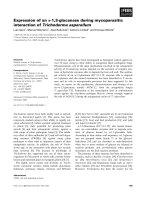
![Tài liệu Báo cáo khoa học: Expression of two [Fe]-hydrogenases in Chlamydomonas reinhardtii under anaerobic conditions doc](https://media.store123doc.com/images/document/14/br/hw/medium_hwm1392870031.jpg)
